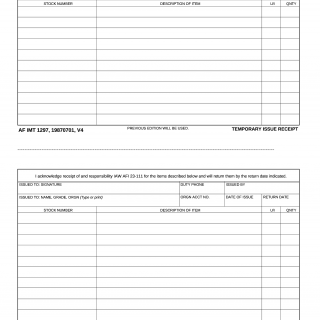AF Form 1297. Temporary Issue Receipt
The AF 1297 form is known as the Temporary Issue Receipt. It is used by the U.S. Air Force to track and document the temporary issuance of equipment or supplies. The main purpose of this form is to provide accountability for items that are issued temporarily and ensure they are returned in a timely manner.
The AF 1297 form consists of several sections including the issuing office, the receiving party, a detailed description of the item(s) being issued, and signatures from both parties. Important fields to consider when filling the form include the date of issuance, condition of the item(s), and expected return date. Both the issuing office and receiving party must sign the form to acknowledge receipt of the items.
This form is important to consider when issuing equipment or supplies in a temporary capacity. Data required when filling out the form includes the description of the item(s) being issued and any identifying information such as serial numbers or part numbers. Additionally, any supporting documentation or instructions should be attached to the form.
Application examples of the AF 1297 form include issuing tools to maintenance personnel or issuing electronics to members on a temporary duty assignment. Practice and use cases vary depending on the needs of the organization. Strengths of this form include its ability to track and document the temporary issuance of equipment or supplies while weaknesses may include the potential for errors or incomplete documentation. Opportunities and threats related to this form will depend on the specific circumstances of its use.
Related forms may include other issue receipts used by different branches of the military or government agencies. Analogues of this form could include similar documents used in private industry or other organizations. The main difference between these forms would likely be the specific requirements for documentation and accountability.
Completing the AF 1297 form correctly affects the future of the participants by ensuring proper use and return of equipment and supplies. This can lead to more efficient operations and cost savings for the organization. The form is typically submitted to the appropriate logistics or supply office and stored in a secure location for record-keeping purposes.

